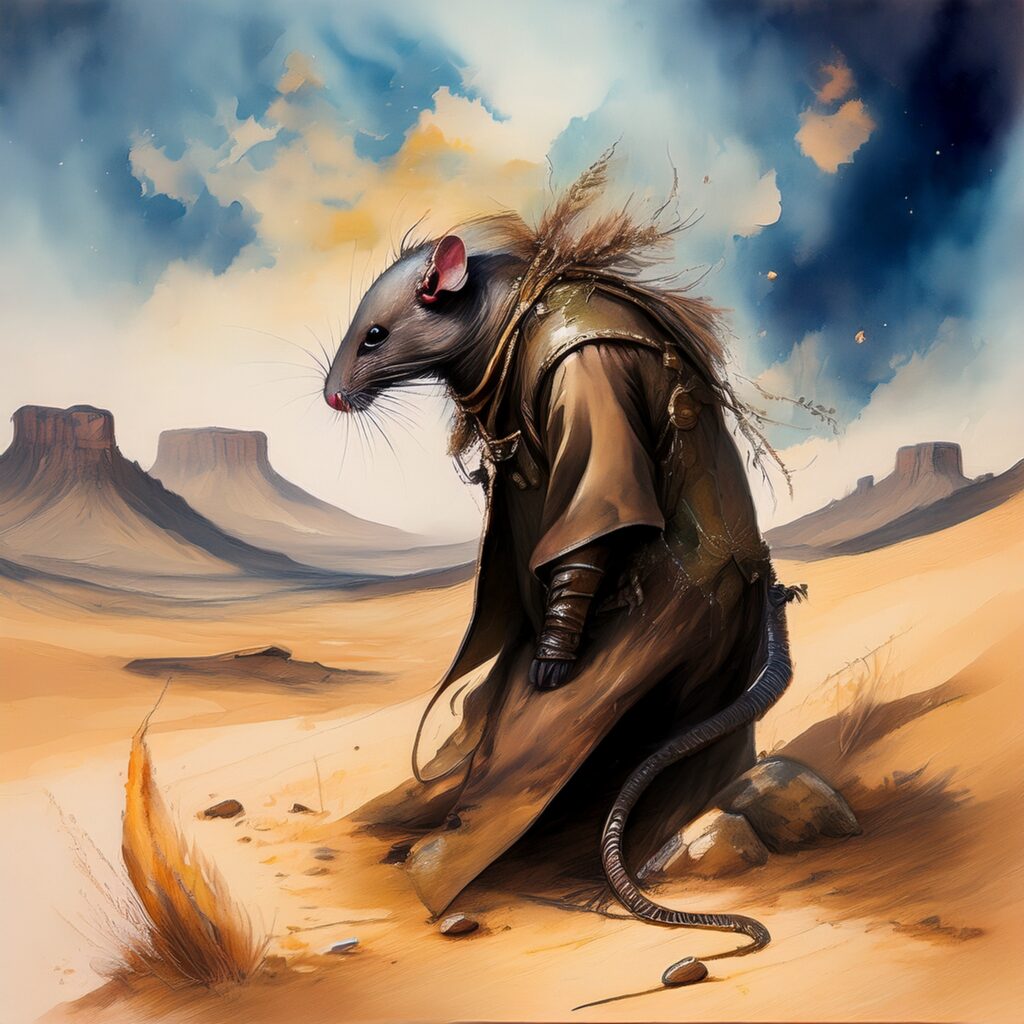Tari

What you at first mistook for some monstrous breed of rat now rears up on its hind legs and chitters at you in indignation. Clad in a ragged assortment of tattered clothing, the creature has matted fur, needle like teeth and a long coiling tail.
The tari are commonly referred to as ratmen by the other denizens of the Tyr region. They are small, furry humanoid scavengers, capable of thriving on food and water too polluted for humans to ingest. Hunted freely as pests, the tari are the barbaric descendants of a once thriving culture who inhabited lands to the south of the Tyr region.
The tari are unimpressive creatures, roughly 4 feet tall and weighing 100 pounds. They move about as bipeds, but sometimes walk on their knuckles. Their tails are about 2 feet long, used mainly for balance, and just strong enough to wrap around a branch and hang from it. Their entire bodies are covered with fine fur, usually brown, but sometimes gray, golden, or even silver, or a combination of any of these. Many tari use dyes from gyava berries to create rings or spots of color for decoration. Males and females alike often braid the longer hair along the back of the neck and the base of the spine and decorate these with beads or feathers.
Tari mouths are filled with needlelike teeth, and to either side they have long black hairs that add to their overall ratlike appearance. Tari seldom wear much clothing, though warriors sometimes have leather jerkins or even chitin greaves. Chieftains and warriors are taller than other tari and. the former are usually highly decorated with dyes, beads, and ceremonial garb.
Tari have a high-pitched, squeaky language of their own. They can send and receive some signals that are beyond the human ear’s ability to hear. Tari can learn other languages, often Common and Elven, though the sounds of humanoid speech are difficult for them to make with their mouths.
Combat
Tari are not natural fighters and prefer to avoid conflict when it comes looking for them. Hunted as vermin, tari are despised by most of the other races of the Tablelands and have learned to live accordingly. When cornered, however, a tari will respond with a vicious bite. Some tari’s produces a natural venom, so that anyone bitten by a tari runs the risk of contracting a nasty disease.
Tari Society
The tari race once boasted a thriving culture far to the south of the Tyr region. Ythri, their legendary capital city, is now a ruin lost among the crags. Their education and knowledge was much greater than it is today, and their technology allowed them to build stone and concrete structures. What happened to their civilization is a mystery; the tari of the Tablelands have no written history. All that remains is a collection of exaggerated myths and legends describing wondrous works. Now the tari live wherever they can – in the underbellies of the cities, the back lots of the villages and the lost and hidden
canyons in the deepest heart of the wild. The lives and attitudes of the urban and wilderness tari are quite different. Both kinds travel in packs, but their approaches to matters of survival are quite disparate. Urban tari live like scavengers, taking whatever they can get hands on and stealing what they cannot easily get. They often approach life in a similar fashion, forming strong attachments that are easily discarded. The tari of the wilderness, however, are nomads who scout for miles in all directions, seeking for the best lands and competing fiercely with the other races of the Tablelands to claim them. In daily life they tend to be harsh and competitive, but given to long-lasting bonds over time.
Other than the individual differences between urban and wilderness tari, the rat folk tend to avoid the other races of the Tablelands as much as possible, wherever necessary. This isolationist behavior is for a very simple reason. Tari are generally despised as vermin by the other races of the Tablelands and are hunted where they are found in the larger cities. It is not a child‘s work, but a warrior can earn a good living hunting tari, as they fetch about 8 Cp per head. Tari are also hunted for their venom glands.
Tari as Characters
Tari characters possess the following racial traits.
Tari Racial Traits
–4 Strength, +4 Dexterity, +2 Wisdom, -2 Charisma: Tari are agile and clever, yet physically weak.
Ratfolk: Tari are humanoids with the ratfolk subtype.
Small: Tari are Small and gain a +1 size bonus to their AC, a +1 size bonus on attack rolls, a –1 penalty on combat maneuver checks and to their Combat Maneuver Defense, and a +4 size bonus on Stealth checks.
Slow Speed: Tari have a base speed of 20 feet.
Darkvision: Tari can see in the dark up to 60 feet.
Rodent Empathy: Tari gain a +4 racial bonus on Handle Animal checks made to influence rodents.
Swarming: Tari are used to living and fighting communally, and are adept at swarming foes for their own gain and their foes’ detriment. Up to two Tari can share the same square at the same time. If two Tari in the same square attack the same foe, they are considered to be flanking that foe as if they were in two opposite squares.
Natural Weapons: Bite (1d3).
Light Sensitivity (Ex): Tari are dazzled in bright sunlight or within the radius of a daylight spell.
Languages: Tari begin play speaking Common and Tari. Tari with high Intelligence scores can choose from the following languages: Aklo, Draconic, Dwarven, Elven, and Halfling.
Tari Favored Class Options
Instead of receiving an additional skill rank or hit point whenever they gain a level in a favored class, Tari have the option of choosing from a number of other bonuses, depending upon their favored class.
The following options are available to all Tari who have the listed favored class.
Alchemist: The alchemist gains +1/6 of a new discovery.
Arcanist: Add 1/3 to the number of times per day the arcanist can use the consume magic items exploit.
Barbarian: When raging, add +1/4 to the barbarian’s swarming trait’s flanking bonus on attack rolls.
Bard: Increase the bonus provided by the bard’s inspire competence performance by 1/6, and add 1/6 to the number of allies the bard can affect with his inspire greatness performance.
Druid: Add a +1 bonus on wild empathy checks made to influence animals and magical beasts that live underground.
Fighter: Add +1 to the fighter’s CMD when resisting a bull rush or grapple attempt.
Hunter: Add 1 skill rank to the hunter’s badger, dire rat, or riding rat (Pathfinder RPG Monster Codex 177) animal companion.
Inquisitor: Add 1/2 to Sense Motive checks and Knowledge (dungeoneering) checks to identify creatures.
Investigator: Add 1 to the bonus provided to a single skill (maximum +2) by inspiration. This skill must be one to which the investigator can already apply inspiration. The investigator can select a different skill at each level.
Mesmerist: Gain a +1 bonus on concentration checks to maintain the mesmerist’s hypnotic stare.
Monk: Add +1 feet to the speed the monk can move while making a Stealth check without taking a penalty. This has no effect unless the monk has selected this reward five times (or another increment of five). This does not allow the monk to use Stealth while running or charging.
Occultist: Gain 1/6 of a new focus power.
Psychic: Gain 1/6 of a new phrenic amplification.
Ranger: Add +1 to an animal companion’s CMD when adjacent to the ranger. If the ranger ever replaces his animal companion, the new animal companion gains this bonus.
Rogue: Add a +1/2 bonus on Escape Artist checks.
Shifter: Add a +1 bonus on wild empathy checks to influence animals and magical beasts that live underground.
Spiritualist: Add 1/2 hit point and 1/2 skill point to the spiritualist’s phantom.
Summoner: Add a +1 bonus on saving throws against poison made by the summoner’s eidolon.
Witch: Add +5 feet to the range of one hex with a range other than “touch.”
Tari Racial Feats
Fever Bite (Tari)
Prerequisites: Character level 5, Tari.
Benefit: you gain the ability to spread Tari Fever with your bite
Tari Fever (Su): Supernatural disease—bite, Fortitude DC 8, incubation period 1d3 days; damage 1d3 Con. The save DC is Charisma-based. Unlike normal diseases, tari fever continues until the victim reaches Constitution 0 (and dies) or is cured with a remove disease spell.
